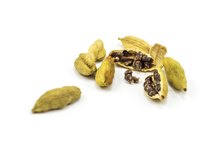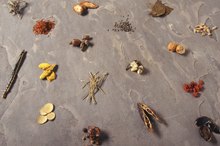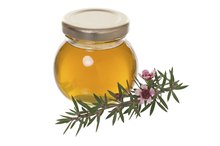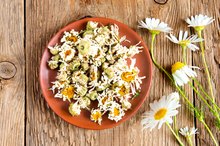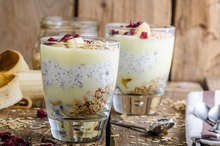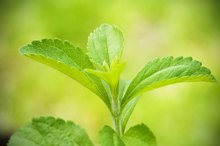What does fact checked mean?
At Healthfully, we strive to deliver objective content that is accurate and up-to-date. Our team periodically reviews articles in order to ensure content quality. The sources cited below consist of evidence from peer-reviewed journals, prominent medical organizations, academic associations, and government data.
- Journal of Clinical Biochemistry and Nutrition: "Gymnema sylvestre: A Memoir"
- Journal of Clinical Biochemistry and Nutrition: "Gymnema sylvestre: A Memoir"
The information contained on this site is for informational purposes only, and should not be used as a substitute for the advice of a professional health care provider. Please check with the appropriate physician regarding health questions and concerns. Although we strive to deliver accurate and up-to-date information, no guarantee to that effect is made.
Herbs That Break a Sugar Addiction
With any addiction, the body becomes dependent on a substance, craving it even when though it may be harmful. Sugar addiction is no different 1. While limiting sugar intake as much as possible is a critical part of the process of breaking the sugar habit, there are herbs and supplements that can also help.
Gymnema Sylvestre
One of the best herbs to help get sugar cravings under control is gymnema sylvestre. Gymnema is an Ayurvedic herb used traditionally to treat diabetes, digestion, urinary tract problems, obesity and hypoglycemia. It is unique in that it actually helps block the taste of sugar and its absorption by the body. One study, published in 2007 in the "Journal of Clinical Biochemistry and Nutrition," notes there is a link between the taste buds and the absorption of sugar in the intestines 2. Gymnemic acid, found in gymnema, has a molecular structure similar to sugar. These molecules fill in the receptors on the taste buds temporarily, preventing the taste buds from being activated by the sugar eaten. It can be found in capsule form or as a liquid extract.
- One of the best herbs to help get sugar cravings under control is gymnema sylvestre.
- It is unique in that it actually helps block the taste of sugar and its absorption by the body.
Licorice
Stevia Powder Vs. Stevia Blend
Learn More
Licorice is used in both cooking and herbal medicine. It is a versatile herb used to treat a variety of conditions, including: hypoglycemia, cough, colds, viral infections, inflammation, ulcers, female complaints, and to increase energy. It stimulates adrenal glands and supports the endocrine system. It is naturally sweet, and can satisfy sugar cravings. However, it does not raise blood sugar levels the same as table sugar. It can be found in powder form or liquid extract, and can be added to teas, or used as a sugar substitute.
- Licorice is used in both cooking and herbal medicine.
- It can be found in powder form or liquid extract, and can be added to teas, or used as a sugar substitute.
Stevia
Stevia is an herb from South America. It is used by herbalists specifically to treat diabetes, and helps lower blood sugar levels. It is extremely sweet and can be used as a sugar substitute to help decrease overall sugar consumption, and satisfy sugar cravings. It can be used in recipes and added to teas, yogurt and cereal. Unlike many sugar substitutes, stevia does not lose its sweetness when used in cooking.
- Stevia is an herb from South America.
- It is used by herbalists specifically to treat diabetes, and helps lower blood sugar levels.
Ginseng
Herbs for Suppressing the Appetite
Learn More
Ginseng root, or panax ginseng, is an Asian herb used to increase energy levels. It is a central nervous system stimulant, and also helps to lower blood sugar levels. Additionally, it can be used to help overcome sugar addictions. However, it does take time for the herb to take effect, as much as two to three months. According to the Herb Guide, a typical dose of ginseng powder is 4,000 to 6,000 mg per day, taken in capsule form 1.
- Ginseng root, or panax ginseng, is an Asian herb used to increase energy levels.
- According to the Herb Guide, a typical dose of ginseng powder is 4,000 to 6,000 mg per day, taken in capsule form 1.
Related Articles
References
- The Herb Guide: Sugar Addiction
- Journal of Clinical Biochemistry and Nutrition: "Gymnema sylvestre: A Memoir"
- Sugars, granulated. USDA FoodData Central. Updated 12/16/2019
- Carbohydrates. Medline Plus. Updated March 13, 2020
- Food Availability and Consumption. United States Department of AgricultureEconomic Research Service. Updated February 28, 2020
- Know Your Limit for Added Sugars. Centers for Disease Control and Prevention. Updated April 3, 2019
- Wölnerhanssen BK, Meyer-gerspach AC. Health effects of sugar consumption and possible alternatives. Ther Umsch. 2019;76(3):111-116. doi:10.1024/0040-5930/a001070
- Delli Bovi AP, Di Michele L, Laino G, Vajro P. Obesity and obesity related diseases, sugar consumption and bad oral health: A fatal epidemic mixtures: The pediatric and odontologist point of view. Transl Med UniSa. 2017;16:11–16. Published 2017 Jul 1.
- Key Recommendations: Components of Healthy Eating Patterns. USDA. Dietary Guidelines 2015-2020
- The New and Improved Nutrition Facts Label – Key Changes. U.S. Food and Drug Administration. Updated March 2020
- Allergy/Intolerance to Sugar. American Academy of Allergy, Asthma, and Immunology. Updated 5/7/2019
- Sugar, granulated. FoodKeeper App. FoodSafety.gov Updated April 26, 2019
Writer Bio
A professional writer since 2008, Tracey Planinz writes articles on natural health, nutrition and fitness. She holds a doctorate and two professional certifications in her field, and continues to develop her education with additional classes and seminars. She has provided natural health consultations and private fitness instruction for clients in her local community.


